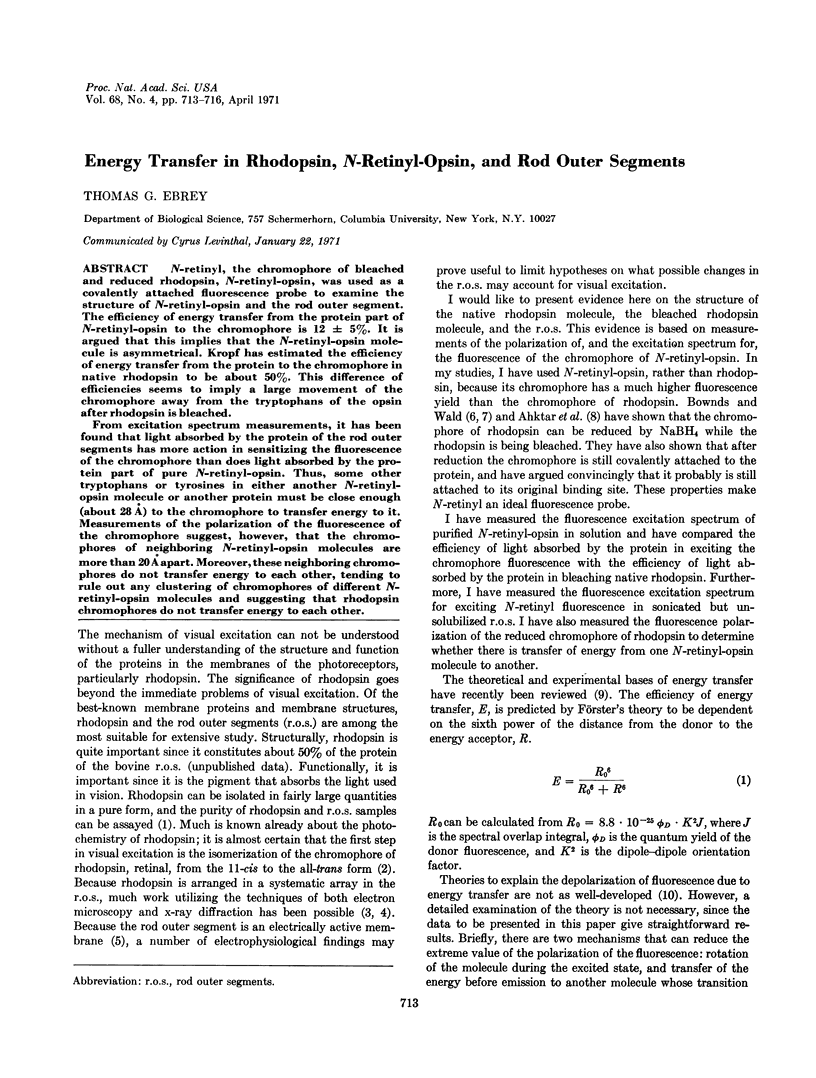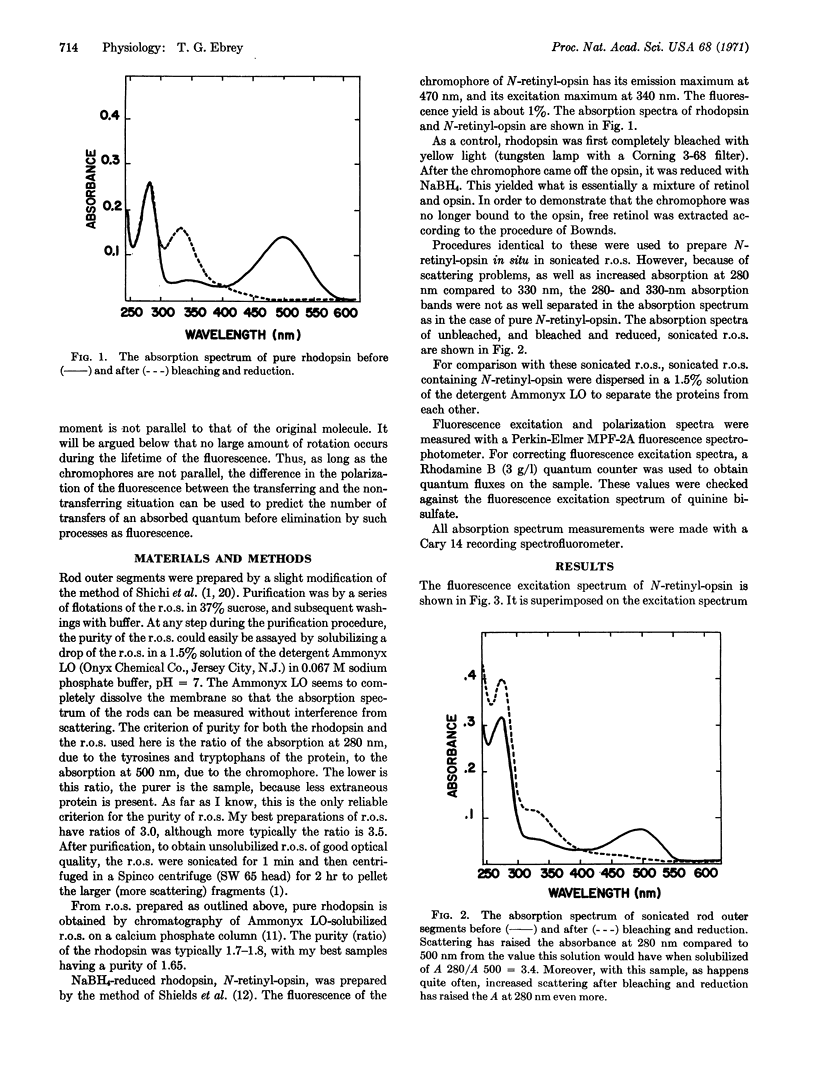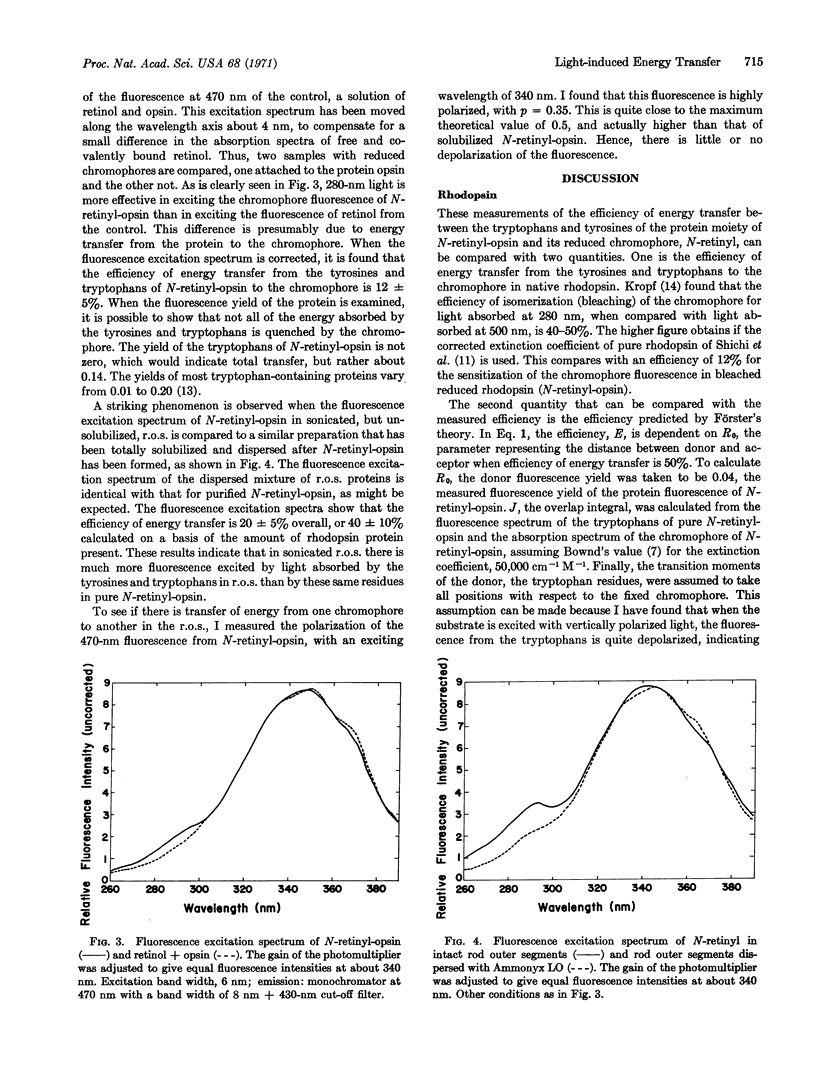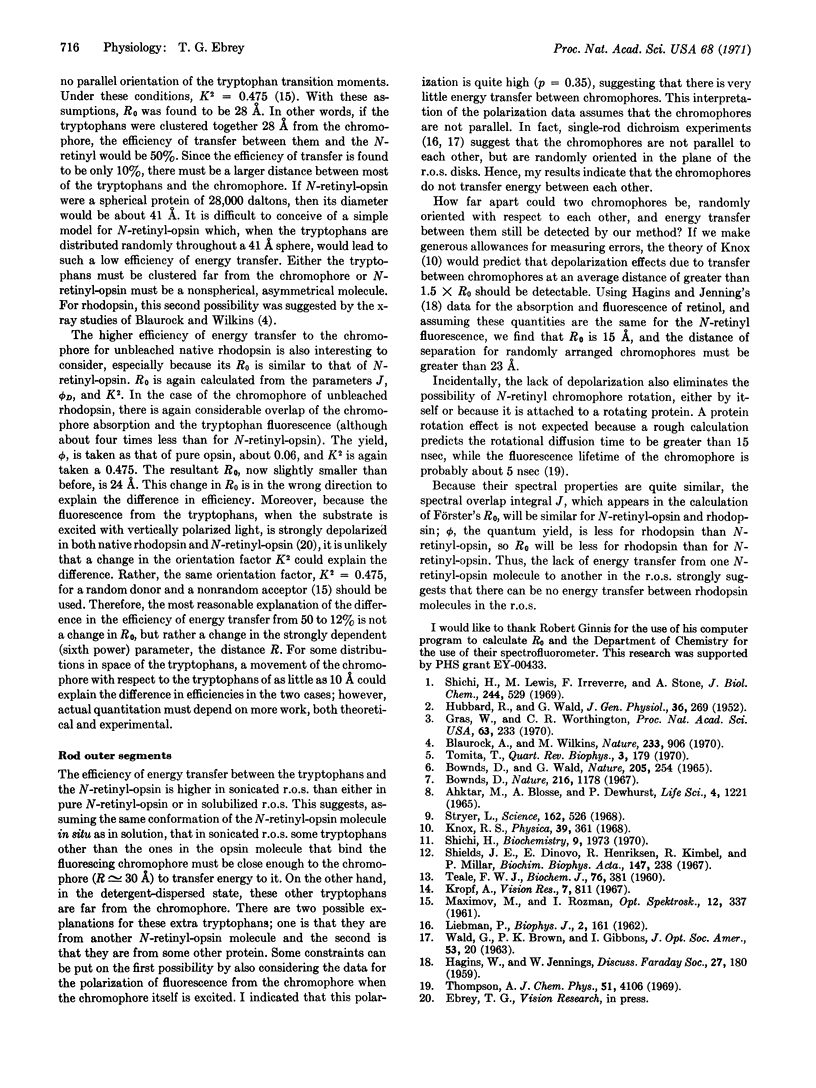Abstract
N-retinyl, the chromophore of bleached and reduced rhodopsin, N-retinyl-opsin, was used as a covalently attached fluorescence probe to examine the structure of N-retinyl-opsin and the rod outer segment. The efficiency of energy transfer from the protein part of N-retinyl-opsin to the chromophore is 12 ± 5%. It is argued that this implies that the N-retinyl-opsin molecule is asymmetrical. Kropf has estimated the efficiency of energy transfer from the protein to the chromophore in native rhodopsin to be about 50%. This difference of efficiencies seems to imply a large movement of the chromophore away from the tryptophans of the opsin after rhodopsin is bleached.
From excitation spectrum measurements, it has been found that light absorbed by the protein of the rod outer segments has more action in sensitizing the fluorescence of the chromophore than does light absorbed by the protein part of pure N-retinyl-opsin. Thus, some other tryptophans or tyrosines in either another N-retinyl-opsin molecule or another protein must be close enough (about 28 Å) to the chromophore to transfer energy to it. Measurements of the polarization of the fluorescence of the chromophore suggest, however, that the chromophores of neighboring N-retinyl-opsin molecules are more than 20 Å apart. Moreover, these neighboring chromophores do not transfer energy to each other, tending to rule out any clustering of chromophores of different N-retinyl-opsin molecules and suggesting that rhodopsin chromophores do not transfer energy to each other.
Full text
PDF



Selected References
These references are in PubMed. This may not be the complete list of references from this article.
- Akhtar M., Blosse P. T., Dewhurst P. B. The reduction of a rhodopsin derivative. Life Sci. 1965 Jun;4(12):1221–1226. doi: 10.1016/0024-3205(65)90336-x. [DOI] [PubMed] [Google Scholar]
- BOWNDS D., WALD G. REACTION OF THE RHODOPSIN CHROMOPHORE WITH SODIUM BOROHYDRIDE. Nature. 1965 Jan 16;205:254–257. doi: 10.1038/205254a0. [DOI] [PubMed] [Google Scholar]
- Bownds D. Site of attachment of retinal in rhodopsin. Nature. 1967 Dec 23;216(5121):1178–1181. doi: 10.1038/2161178a0. [DOI] [PubMed] [Google Scholar]
- Gras W. J., Worthington C. R. X-ray analysis of retinal photoreceptors. Proc Natl Acad Sci U S A. 1969 Jun;63(2):233–238. doi: 10.1073/pnas.63.2.233. [DOI] [PMC free article] [PubMed] [Google Scholar]
- HUBBARD R., WALD G. Cis-trans isomers of vitamin A and retinene in the rhodopsin system. J Gen Physiol. 1952 Nov;36(2):269–315. doi: 10.1085/jgp.36.2.269. [DOI] [PMC free article] [PubMed] [Google Scholar]
- Irreverre F., Stone A. L., Shichi H., Lewis M. S. Biochemistry of visual pigments. I. Purification and properties of bovine rhodopsin. J Biol Chem. 1969 Feb 25;244(4):529–536. [PubMed] [Google Scholar]
- Kropf A. Intramolecular energy transfer in rhodopsin. Vision Res. 1967 Nov;7(11):811–818. doi: 10.1016/0042-6989(67)90001-6. [DOI] [PubMed] [Google Scholar]
- LIEBMAN P. A. In situ microspectrophotometric studies on the pigments of single retinal rods. Biophys J. 1962 Mar;2:161–178. doi: 10.1016/s0006-3495(62)86847-7. [DOI] [PMC free article] [PubMed] [Google Scholar]
- Shichi H. Spectrum and purity of bovine rhodopsin. Biochemistry. 1970 Apr 28;9(9):1973–1977. doi: 10.1021/bi00811a018. [DOI] [PubMed] [Google Scholar]
- Shields J. E., Dinovo E. C., Henriksen R. A., Kimbel R. L., Jr, Millar P. G. The purification and amino acid composition of bovine rhodopsin. Biochim Biophys Acta. 1967 Oct 23;147(2):238–251. doi: 10.1016/0005-2795(67)90402-3. [DOI] [PubMed] [Google Scholar]
- Stryer L. Fluorescence spectroscopy of proteins. Science. 1968 Nov 1;162(3853):526–533. doi: 10.1126/science.162.3853.526. [DOI] [PubMed] [Google Scholar]
- TEALE F. W. The ultraviolet fluorescence of proteins in neutral solution. Biochem J. 1960 Aug;76:381–388. doi: 10.1042/bj0760381. [DOI] [PMC free article] [PubMed] [Google Scholar]
- WALD G., BROWN P. K., GIBBONS I. R. The problem of visual excitation. J Opt Soc Am. 1963 Jan;53:20–35. doi: 10.1364/josa.53.000020. [DOI] [PubMed] [Google Scholar]


